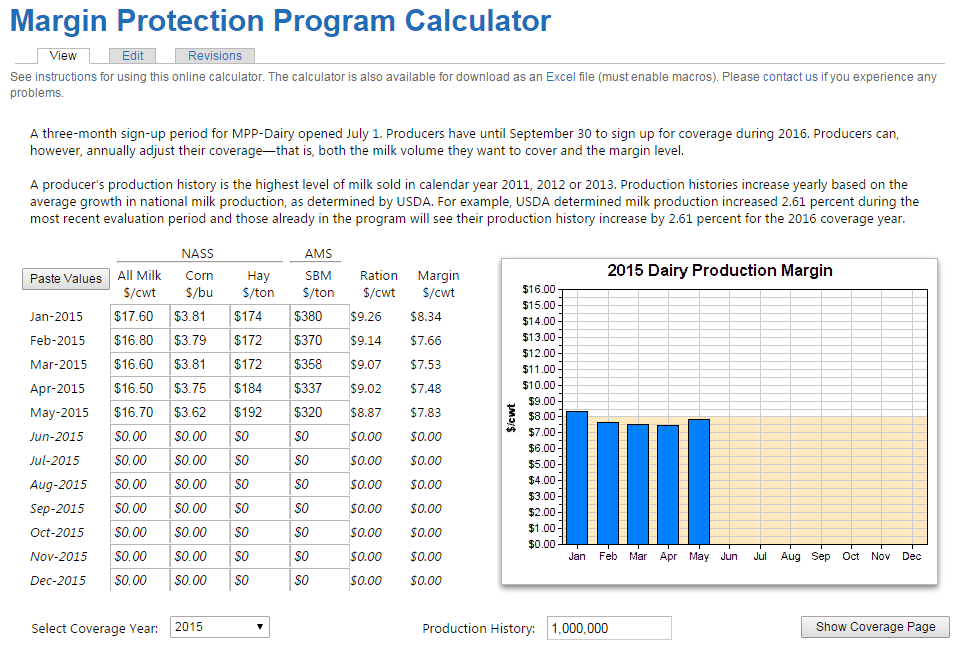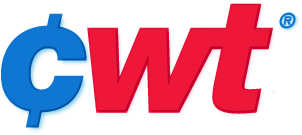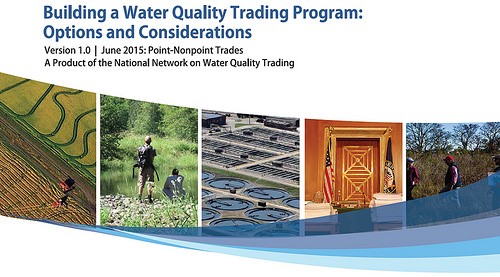2nd Enrollment Period Opens for New Federal Dairy Safety Net
July 12, 2015 The second enrollment period for the Margin Protection Program — the new federal dairy safety net included in the 2014 farm bill — opened July 1st. Producers have until Sept. 30th to sign up at their county FSA office for coverage in 2016.
The second enrollment period for the Margin Protection Program — the new federal dairy safety net included in the 2014 farm bill — opened July 1st. Producers have until Sept. 30th to sign up at their county FSA office for coverage in 2016.
MPP helps protect against the kind of catastrophic losses that many dairy farmers experienced in 2009 and again in 2012. It does this by allowing farmers to use insurance to cover the margin between milk prices and feed costs. Producers insure their operations on a sliding scale, deciding both how much of their production to cover and the level of margin to protection.
NMPF was instrumental in MPP’s enactment and strongly encourages producers to use the program going forward.
To help farmers make coverage decisions, NMPF has updated the informational tools at the www.FutureforDairy.com website serving as a clearinghouse for information on MPP. Included are a brochure explaining the program and its importance to dairy farmers; a PowerPoint presentation that also highlights the benefits of the program; Frequently Asked Questions on the MPP; and a calculator allowing farmers to estimate future margins based on their forecasts of feed and milk prices.
With TPA Signed, Stage Is Set to Complete Pacific Trade Deal Soon
July 12, 2015With Trade Promotion Authority legislation finally passed through Congress and signed by President Obama, the stage is set to wrap up negotiations on a critically important Pacific Rim t rade agreement and send it to Congress by the end of the year.
rade agreement and send it to Congress by the end of the year.
“We’re going to be having some conversations over the coming days to make sure we are on track toward closing,” said U.S. Trade Representative Michael Forman on July 1. He added that the likelihood Congress will approve the agreement is “pretty high.”
Obama signed the TPA bill June 29, closing the door on a grueling 10-week congressional process that saw the legislation left for dead at least once. NMPF strongly supported TPA as a key to negotiating a favorable deal on dairy in the 12-nation Trans-Pacific Partnership and also expanding other potential trade opportunities for the industry.
“Getting TPA in place is essential to increasing pressure on trading partners like Japan and Canada to improve their offers,” said NMPF President and CEO Jim Mulhern. “It signals that the United States is serious about trade negotiations.
“TPA also governs the rules for how Congress will review and approve trade agreements,” Mulhern said. “TPA allows negotiators to finish their job and then allows a meaningful debate on the merits of these agreements. TPA now must be used by our negotiators to conclude a positive TPP outcome for U.S. dairy producers so that we are able to realize the net trade benefits we need.”
Key to dairy’s agenda in the TPP negotiations is opening up the Japanese and Canadian markets to more U.S. dairy products and limiting additional access to our markets for New Zealand dairy farmers.
NMPF has consistently stressed that the merits of the final TPP package will hinge in large part on whether USTR insists on a truly balanced dairy outcome that generates real net trade benefits for U.S. dairy exports into Japan and Canada in comparison with new dairy access into the U.S. for New Zealand’s exports.
Mulhern Grills Head of WIPO on Outcome of May Conference on Food Names
July 12, 2015As a follow-up to a contentious diplomatic conference that expanded geographical indications protections for European countries, NMPF President and CEO Jim Mulhern personally pressed the  head of the agency that convened the conference on both its outcome and the process used to reach that outcome.
head of the agency that convened the conference on both its outcome and the process used to reach that outcome.
Treaty changes approved at the May conference held by the World Intellectual Property Organization, or WIPO, risk seriously impairing the ability of companies worldwide to use generic food terms in export markets. Among those affected are U.S. dairy producers and processors relying on numerous generic cheese names.
“This was a very unfortunate missed opportunity to actually help achieve a global consensus document on GIs, rather than simply create a divisive process that disregarded the concerns of many members,” said Mulhern. “We view it as entirely unjustified for individual countries to be permitted to ban competition by monopolizing terms for types of food that long ago entered into common usage in many countries.”
Mulhern criticized a closed process used during the two-week conference to deny meaningful participation by a majority of WIPO members, including the United States.
“For the past 25 years, WIPO members have been able to fully participate in negotiations on international treaties, even if they were not members of that particular treaty,” Mulhern said. “For the May conference, this precedent was tossed aside so that the concerns of the United States and other active WIPO members could be side-lined.” As a result, Mulhern added, the treaty signed at the meeting “cannot be held up as a legitimate international agreement.”
Mulhern led the meeting with WIPO Director General Francis Gurry in Washington in mid-June. Also participating were representatives of the International Dairy Foods Association, the Grocery Manufacturers Association, the American Farm Bureau Federation and several other trade associations concerned with the issue of geographical indications.
Failing to Heed NMPF Concerns, USDA Okays Beef Imports from Argentina and Brazil
July 12, 2015 Failing to heed NMPF concerns about an earlier risk assessment, the Agriculture Department in late June updated its rules to allow imported fresh beef from northern Argentina and 14 states in Brazil. The rules, which allow the imports under conditions that mitigate Foot and Mouth Disease risks, will become final in late summer or early fall.
Failing to heed NMPF concerns about an earlier risk assessment, the Agriculture Department in late June updated its rules to allow imported fresh beef from northern Argentina and 14 states in Brazil. The rules, which allow the imports under conditions that mitigate Foot and Mouth Disease risks, will become final in late summer or early fall.
NMPF had expressed concerns over a risk assessment performed by the Animal and Plant Health Inspection Service that indicated the beef could be imported safely. It urged that APHIS conduct a separate quantitative risk assessment similar to one used for importing similar products from Uruguay.
NMPF Vice President for Sustainability and Scientific Affairs Jamie Jonker expressed disappointment that the department did not strengthen the risk analysis. “This demonstrates the need to enhance U.S. Foot and Mouth Disease preparedness, including modernization of the North American FMD vaccine bank with appropriate types and quantities available for use in an FMD outbreak,” Jonker said.
In light of concerns raised by NMPF and other farm groups, the House Appropriations Committee voted last week to stop the USDA from lifting the beef ban. The provision – part of the annual agriculture appropriations bill still pending in Congress – wouldn’t permanently stop the department from lifting the ban. It would require the USDA to perform another comprehensive risk analysis on FMD in Brazil and Argentina, make visits to both countries and submit a report to Congress before changing the ban.
USDA, CSPI Agree with NMPF on Need to Ease Restrictions on Milk in Schools
July 12, 2015Federal legislation easing restrictions on serving chocolate milk in schools received expressions of support in June from two prominent sources: the U.S. Department of Agriculture and the Center  for Science in the Public Interest.
for Science in the Public Interest.
The School Milk Nutrition Act, developed jointly by NMPF and the International Dairy Foods Association and introduced in Congress this spring, would stem the tide of declining school milk consumption, among other ways, by allowing schools to offer low-fat as well as fat-free flavored milk. Current regulations only allow flavored milk if it is non-fat. Low-fat flavored versions would be restricted to no more than 150 calories per eight-ounce serving under the new legislation.
At a June hearing of the House Education and Workforce Committee, USDA Secretary Tom Vilsack was asked if he could support giving schools the option of offering low-fat flavored milk. According to the Washington publication Politico, Vilsack responded, “I think if adding that option gets kids to drink more milk, we ought to do it.”
Later in the month, Margo Wootan, CSPI’s director of nutrition policy, also supported the concept of relaxing restrictions on flavored milk in schools. Politico quoted Wootan as saying, “I think that having flavored milk in schools is fine. It’s better to have kids drinking fat-free chocolate milk than soda. And one percent milk with a calorie cap is also acceptable to us.”
CSPI, sometimes called the “food police,” is a prominent consumer organization on nutrition issues.
The School Milk Nutrition Act was introduced earlier this year by Representatives Glenn Thompson (R-PA) and Joe Courtney (D-CT) and now has 12 cosponsors. A response to a significant drop in school milk servings since 2012, it reaffirms the requirement that milk be offered with each school meal, and that a variety of milk be offered consistent with the Dietary Guidelines for Americans. It also would establish a pilot program designed to increase milk consumption through expanded breakfast programs, a la carte sales, and other new outlets.
CWT Helps Move 9.4 Million Pounds of Dairy Products into World Markets
July 12, 2015Cooperatives Working Together helped its member cooperatives last month contract to sell 9.447 million pounds of dairy products to customers in 12 countries on four continents. The 3.6 million pounds of American-type cheese, 3.8 million pounds of butter, and 2.0 million pounds of whole milk powder will be shipped from June through November 2015.
pounds of American-type cheese, 3.8 million pounds of butter, and 2.0 million pounds of whole milk powder will be shipped from June through November 2015.
The 40 sales contracts in June bring the year to date 2015 totals to 38.4 million pounds of cheese, 30.4 million pounds of butter, and 22.1 million pounds of whole milk powder. Together, those transactions will move the equivalent of 1.2 billion pounds of milk on a milkfat basis to customers in 28 countries on five continents. These sales contracts are equal to nearly 90 percent of the increase in U.S. milk production through May.
Developed by NMPF, CWT is a voluntary export assistance program supported by dairy farmers producing 70 percent of the nation’s milk. By helping to move U.S. dairy products into world markets, CWT helps maintain and grow U.S dairy farmers’ share of these expanding markets.
In a related development, in early June the NMPF board voted to continue CWT through 2018 at the current funding level of four cents per hundredweight. The extension comes at a time of increasing U.S. milk production, declining world dairy prices and increased global competition due to the removal of European Union milk quotas.
“With the United States exporting the equivalent of one-seventh of its milk production, the NMPF board recognized how important CWT is in helping every farmer gain access to fast-growing overseas markets,” said NMPF Board Chairman Randy Mooney. “The program remains a tremendous self-help tool for all of America’s dairy producers.”
Importance of Voluntary National GMO Labeling Standards Reinforced at Hearing
July 12, 2015Testimony at June hearing before a key House subcommittee reinforced the importance of a establishing national standard for labeling foods with genetically modified ingredients, rather than  allowing a patchwork of state requirements.
allowing a patchwork of state requirements.
“State-by-state GMO labeling is simply not an option, as testimony at this and earlier hearings has shown,” said Jim Mulhern, NMPF President and CEO. “A better approach is federal legislation endorsed by NMPF that would set up voluntary regulations for labeling foods with GMO ingredients.”
That legislation, the Safe and Accurate Food Labeling Act, requires the Food and Drug Administration to set standards for companies wishing to label products as either containing or not containing GMOs. It was introduced this spring by Reps. Mike Pompeo (R-KS) and G.K. Butterfield (D-NC).
“The Pompeo-Butterfield bill would deal with GMO labeling at the national level,” Mulhern said. “It would set uniform rules and provide a national certification program for foods that have been produced without bioengineering.”
In March, Vermont dairy farmer Joanna Lidback and Land O’Lakes Chief Executive Office Chris Policinski testified on GMO labeling before the House Agriculture Committee. Lidback said genetically modified seeds keep her farm’s feed bills low and allow her to use less fertilizer and pesticides. Her state has enacted a mandatory GMO labeling bill that is scheduled to go into effect next year.
Policinski said state GMO labeling “would be a logistical nightmare, creating dozens of different standards, different definitions, and different exemptions.”
GMOs have been proven safe by nearly 2,000 studies from the leading scientific bodies in the world, including the World Health Organization and the American Medical Association. Currently, up to 80 percent of the food available in the United States contains genetically modified ingredients.
NMPF among 18 Authors of a New Guide to Water Quality Trading
July 12, 2015 NMPF was among 18 organizations that in June unveiled an online guide to water quality trading programs designed to help farms, utilities and others reduce pollution.
NMPF was among 18 organizations that in June unveiled an online guide to water quality trading programs designed to help farms, utilities and others reduce pollution.
Like energy trading, water quality trading rewards those who act responsibly with credits that they can keep or sell to others. For example, a farmer who reduced runoff can earn credits that can be sold to a wastewater treatment plant that is discharging into a river.
While regulations vary from sector to sector — wastewater plant regulations are different from those that apply to farms — water quality trading leads to cleaner waterways at lower cost.
But establishing a trading program can be challenging. Start-up is time-consuming, as businesses and regulators figure out how much pollution participants must cut, how pollutants interact in different parts of the watershed, and other program elements.
The new guide, Building a Water Quality Trading Program: Options and Considerations, helps participants decide if trading is right for their watershed. It lists 11 key elements in trading program design, with examples, options, and clear pros and cons.
“The guide offers options for calculating credits, determining trading eligibility and engaging stakeholders,” said Ryan Bennett, NPPF’s Director of Government Relations. “Clear pros and cons give stakeholders the flexibility to address the scientific, social, and ecological realities of a particular watershed. Overall, the guide is an excellent resource that can help participants design a trading program faster and with less cost.”
The guide’s authors, including NMPF staff, represent agricultural operations, wastewater utilities, environmental groups, regulatory agencies and trading program designers. All are members of a two-year old National Network on Water Quality Trading.





